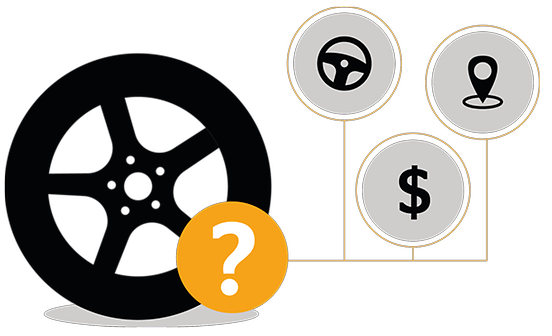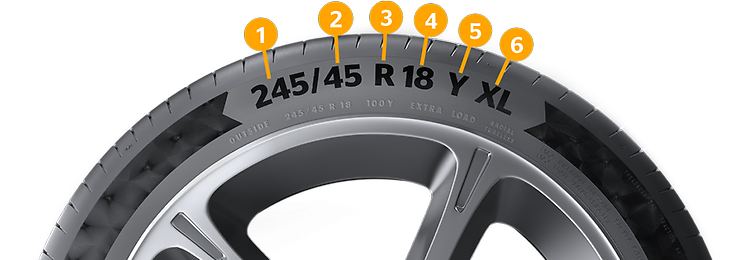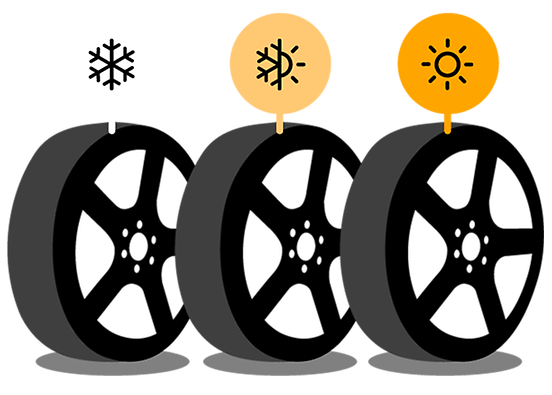Buying Tires
Buying Tires
Guide To Buying New Tires
Before you buy new tires, educate yourself on the subject.
Quick facts: Checklist for new tires
Check your vehicle's paperwork for tire compatibility
- The width, diameter, and height-to-width aspect ratio of a tire define its size
- The load index indicates how much weight your vehicle can support.
- The speed rating indicates the highest speed that the tire can achieve.
- Install the same tire model and brand on all four wheel positions.
The tires determine your vehicle's performance and handling. After all, the sole point of contact between the automobile and the road is the tire.
So, when it comes time to buy new tires for your vehicle, there are several factors to consider, including your driving style, budget, and the region in which you live.


Key requirements
The first criterion for selecting new tires is that they are suitable for your car. A list of suitable tire types will be included in your owner's handbook and literature. The main properties of a tire may also be seen on its sidewall. Examine the tires that are currently on your vehicle and utilize it as a starting point.
We highly advise that a vehicle utilize the same tires on all four wheels. This consistency is critical to sustaining performance and control.
Tire dimensions are given in terms of width, diameter, and height-to-width aspect ratio. The width is a three-digit value that measures the distance in millimeters between one sidewall and the other (1). The ratio denotes the percentage of the tire width to the sidewall height (2).
Tire structure can also vary, as denoted by the letter R-radial (3). Cross-ply tires were the most prevalent until the 1970s; they had a casing consisting of rubberized cord plies with edges wrapped around the bead wire. Radial tires have totally superseded cross-ply tires in current automobile manufacture. A radial tire casing's wires run perpendicular to the direction of motion.
The cords run radially when viewed from the side, giving the tire its name. The diameter, indicated in inches, must correspond to your vehicle's wheel size (4).
The load index indicates how much weight a tire can support. The load indices of passenger tires range from 75 to 105. Calculate the weight using the index, then multiply it by the number of tires to get the total load supported.
The maximum speed the tire is capable of is indicated by a letter on the sidewall (5). Keep in mind that tires with a greater maximum speed typically have faster tread wear. The speed rating must be at least as high as the maximum speed of the vehicle.
The automobile manufacturer will also give you information on the recommended tire pressure for best vehicle performance. Using a tire near its maximum rated pressure is dangerous since it alters vehicle control and increases tire wear.
Check the sidewall for further information such as load capacity (6), safety regulations and association symbols. They will inform you if it is approved for your nation and if it fulfills common quality criteria.
Alternative considerations
Taken together, the primary tire criteria cut down your options. Nonetheless, there are several alternative possibilities for passenger tires. The ideal tire for you is determined by your driving style and budget.
Do you want a quiet, pleasant ride? tire treads in this category are designed to reduce noise. However, the tread rubber may be softer, increasing the rate of wear. As a result, quiet tires are ideal for paved roads.
Or are you seeking for tires that are the most fuel efficient? These tires have a lower rolling resistance tread, which results in much better fuel consumption.
Tire flexibility is vital if you drive on rough roads or love off-roading. An all-terrain tire may suffice. Consider the extra sidewall protection of an off-road tire. Many specialty truck tires, such as mud tires, provide additional traction for a variety of terrains.
Finally, keep in mind that different tire types perform differently. Allow for some adjustment time when driving, accelerating, and braking with new tires.

Winter, summer, and all-season tires
Throughout the year, driving conditions change. So, when it comes time to buy new tires, the first thing you should do is consider your local climate. Depending on your region's environment, it may be advisable to rotate between a pair of summer and winter tires, or all-season tires may suffice.
Winter tires feature a tread pattern that is excellent on snow and slush and can endure cold conditions. Above all, they provide improved handling and shorter braking distances on snow and ice.
Summer tires provide good road grip, handling, and reduced braking distances on dry roads while also managing slippery roads after heavy rain.
Continental all-season tires perform well in a range of weather situations. All-season tires are an option for drivers who live in areas with mild winter weather (temperatures seldom dip below freezing). Continental all-season tires provide both safety and performance. Furthermore, drivers can save money, time, and effort required for seasonal tire changes.
If you are undecided about which tires to buy, please consult with your local dealer.
Original equipment manufacturer tires
Your vehicle already has tires mounted. These are the original equipment (OE) tires selected by the car manufacturer, which have passed a battery of rigorous testing and satisfy their exact specifications. OE tires might be new designs, modifications to existing tires, or a preferred stock tire. Choosing OE tires for their car is a simple and straightforward solution for many owners.
Copyright © 2023 Continental Middle East DMCC All rights reserved.







